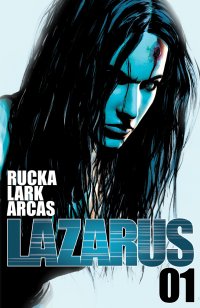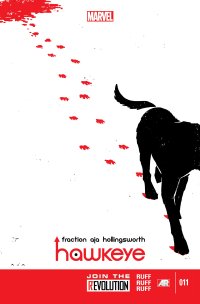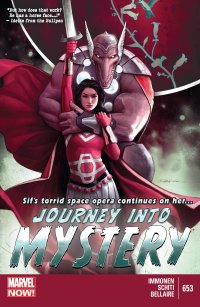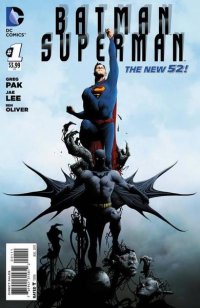Lazarus #1($2.99, Image)
by D.S. Randlett (@dsrandlett)
We’re up to our elbows in fictional versions of our own society either going through apocalypse, or recovering from it. Zombies have become something of a mainstream cliche begun by the great Danny Boyle film 28 Days Later, but that movie brought more than Zombies back to our fiction. The most omnipresent of the 28 Days Later spawn to not feature some variation on the undead is the YA novel and film series, The Hunger Games, which is one of many stories in the past ten years to run with a vision of our own culture driving toward an extreme version of itself. The subgenre and the ideas are nothing new, of course, but its proliferation certainly is. Lazarus is another entry into this subgenre, but do the much-vaunted skills of Greg Rucka and Michael Lark have anything new to bring?
If not, Rucka and Lark at the very least bring a sense of realism and sheer ability to the proceedings. The world of Lazarus appears to have been devastated by global warming, gotten across by Lark’s portrayal of a setting that looks mostly like a dried out husk, and American society has become something more akin to the feudal societies seen throughout Europe after the fall of Rome crossed with the Mafia, what with the small, powerful families that control the post-collapse resource infrastructure. But then, the feudal fiefdom and the Mafia family were both outgrowths of the Roman “beneficium” system that was steadily becoming more and more popular as Roman institutions atrophied, a phenomenon that seems to be very much on Rucka’s mind here. It’s also unique in the subgenre in that it feels more like a crime novel than outright sci-fi, which itself hints at some potentially profound thematic material for the series as it progresses. “Power is itself a criminal act” seems to be where we’re going here.
The plot revolves around a woman named Forever, engineered to be the perfect physical specimen with the ability to recover very quickly from, well, death. There’s a bit of introductory text that explains that there are people like this in all of the so-called families, and that they are referred to as Lazari. They’re meant to be security enforcers, protecting the family resources, and thus the family power, but they also functions as symbols of that power. After a harrowing episode involving some starving thieves at a low-security family compound, and the events shortly following, Forever starts to confront a nagging feeling that something is wrong. Much to the consternation of her handlers, of course.
As a first issue, Lazarus could be a lot worse. Rucka writes with a clarity and focus almost unparalleled in the field. So, by the end of the issue, we barely have an idea of where we’re headed, but Rucka has clearly established a set of stakes that make you want to find out, a rarity for the seemingly constant stream of first issues coming out of Image these days. Lark’s art is as good as ever. His storytelling is especially great in the gory action opener, but he conveys the ensuing talkier bits with a sense of drama that’s equally hard to pass up.
Lazarus is a really solid first issue, but there are the seeds here of something that could end up being really great. If nothing else, Rucka has a much firmer and subtler grasp on the subjects that he’s critiquing than pretty much anyone else currently working with this subgenre.
Rating: 




Out of a Possible 5 Stars
Hawkeye #11 (Marvel,$3.99)
Young Avengers #6 (Marvel,$3.99)
Journey Into Mystery #653 Marvel,$3.99)
By Jeb D.
 When we had to postpone last week’s column, I was thinking that gave me another week to prepare to unload on the pointlessness of the wrapup to, and entire concept of, Marvel’s Age of Ultron series. But you know what? Fuck that. This week, Marvel releases the latest issues of three of their best series of the 21st century, so why not celebrate that instead?
When we had to postpone last week’s column, I was thinking that gave me another week to prepare to unload on the pointlessness of the wrapup to, and entire concept of, Marvel’s Age of Ultron series. But you know what? Fuck that. This week, Marvel releases the latest issues of three of their best series of the 21st century, so why not celebrate that instead?
What do you do after your new comic series gets nominated in virtually every Eisner category, and knocks The Walking Dead off the top spot of the trade paperback charts? Well, if you’re Matt Fraction and David Aja’s Hawkeye, you go for something as gimmicky and attention-hungry as telling a mystery story starring, and seen through the eyes of, a dog. A painfully cute concept, and so trite that it couldn’t possibly work… well, unless it was executed with remarkable imagination, scrupulous insight, and a large dose of genius… in other words, unless it was precisely this comic.
“Pizza is my Business” is a classic detective story, recast through the perspective of Lucky (aka Pizza Dog), the dog whose life Hawkeye saved back in issue #1. In a surprisingly organic way, Fraction and Aja have put him to work this month solving the murder, from last issue, of Clint’s neighbor Grills. I’d be doing this comic (and your reading experience) a disservice to try and reveal too much detail about the various approaches that the book takes to making this feel natural, and not something out of a “Benji” movie, but picture a dog’s eye view of the world that owes something to the iconography of contemporary urban life, the linearity of Chris Ware, among others, and that demands that same level of visual involvement by the reader.
Every page—hell, almost every panel—pulses with the ingenuity of the concept: as one example, throughout the issue, Lucky can only comprehend the words he’s been trained to respond to, so when Kate Bishop is trying to get Clint to smarten up his shirt, Lucky only picks up the words “collar” and “stay”; all the rest, to him, is noise. There’s even the femme fatale that every detective must encounter, and readers familiar with Clint’s character will find wonderful parallels in Lucky’s reactions to his own dangerous dame. The layering of the story is amazing: it may take you a few pages to completely get how you’re supposed to view Lucky’s world, but once you do, it makes perfect sense, and allows Fraction an extra level or two to work with, while providing readers with the cheerful frisson of discovery at each new element. Matt Hollingsworth’s color palette is equally important, carefully sectioning off those parts of the human world that fall within Lucky’s experience, and those which lie outside it.
And this comic’s not just cleverly conceived and brilliantly executed, its emotional range is stunning: it’s got some of the funniest moments this series has brought us so far (the image here is probably too small, but check out the fullsize version of the cover for one of the best jokes), and the somewhat startling ending is perfectly measured, forcing the reader to go back through the book again for clues to where Hawkeye is headed next.
Normally, I’d fear overselling the virtues of a comic like this, but I’m not really sure I could: it’s easily the best single issue I’ve read this year.
Young Avengers takes a bit of a swerve this month, with a fill-in artist, Kate Brown (Fish & Chocolate), and focusing  on two new members of the team: former New X-Man Prodigy (David Alleyne) and Wiccan’s half-brother Speed (Tommy Shepherd). And as good as the series’ first arc was, this might be the best single issue yet. It’s a model of just how much Kieron Gillen can get out of 22 pages of comic, beginning with brilliantly economical character introductions, making the developing friendship between David and Tommy feel earned, despite the compressed amount of space he has to devote to it, and moves the story smoothly from meta-humor reminiscent of Dan Slott’s She-Hulk, to the two characters’ very different perspectives on the drudgery of the working life, to a concluding cliffhanger that is disturbingly creepy.
on two new members of the team: former New X-Man Prodigy (David Alleyne) and Wiccan’s half-brother Speed (Tommy Shepherd). And as good as the series’ first arc was, this might be the best single issue yet. It’s a model of just how much Kieron Gillen can get out of 22 pages of comic, beginning with brilliantly economical character introductions, making the developing friendship between David and Tommy feel earned, despite the compressed amount of space he has to devote to it, and moves the story smoothly from meta-humor reminiscent of Dan Slott’s She-Hulk, to the two characters’ very different perspectives on the drudgery of the working life, to a concluding cliffhanger that is disturbingly creepy.
Brown makes no attempts to ape McKelvie and Norton’s distinctive style, but she has a striking visual sense of her own, some very smart paneling choices in the action sequences, and a great feel for the posture and bearing of adolescent boys; she also appears to have done the excellent coloring herself. For regular readers of Young Avengers, this issue may look like a bit of a breather till next time, but that’s deceptive: new readers and old will be equally drawn in and compelled not to miss issue 7.
Of course, Young Avengers grew out of Gillen’s concluding run on Journey Into Mystery, and if Kathryn Immonen’s Sif-centered followup hasn’t captured the tumblr crowd in the same Sandman-like way that her predecessor did, she’s done her usual excellent job of centering a not-entirely-traditional comic-book adventure story around an interesting female protagonist, whose virtues and flaws are equally well drawn.
 Longtime Thor fans will enjoy Sif’s prickly reunion with Beta Ray Bill, though it’s possible that new readers will wonder whether or not these two really were an item back in the day (Warren Ellis, after all, once famously referred to Bill as “a horse from space”). What’s best about their reunion is that Immonen weaves the kinds of doubts and uncertainties that lie at the heart of sundered relationships, with the mysteries underlying their respective quests. And as with both the other books under consideration here, the ending adds a level of additional mystery as we head into the middle of the story.
Longtime Thor fans will enjoy Sif’s prickly reunion with Beta Ray Bill, though it’s possible that new readers will wonder whether or not these two really were an item back in the day (Warren Ellis, after all, once famously referred to Bill as “a horse from space”). What’s best about their reunion is that Immonen weaves the kinds of doubts and uncertainties that lie at the heart of sundered relationships, with the mysteries underlying their respective quests. And as with both the other books under consideration here, the ending adds a level of additional mystery as we head into the middle of the story.
Artist Valerio Schiti continues to delight with his melding of space opera and sword & sorcery, and in his hands (with typically fine colors from Jordie Bellaire), Sif is one of the most visually distinctive and expressive female characters on the stands today.
JIM’s the sad story of the bunch, though: while Hawkeye’s success has been something of a surprise (it’s the kind of book that you’d expect might need a fanbase to rally furiously to keep it alive), and Young Avengers seems to be percolating right along, it’s already been announced that Immonen’s current arc will be her (and JIM’s) last. I wonder if scheduling was part of the problem: for the past couple of years, these three books, among the cream of Marvel’s current crop, have been coming out the same week each month; it may be that too many Marvel readers found themselves able to stretch to two of these fine books in a week, but not three. And as happy as I am to see Hawkeye and Young Avengers thrive, Kathryn Immonen might be the most seriously undervalued writer working in mainstream comics today, and she deserves an audience.
Ratings:
Hawkeye #11– Rating: 




Out of a Possible 5 Stars
Young Avengers #6– Rating:





Out of a Possible 5 Stars
Journey Into Mystery #653– Rating:





Out of a Possible 5 Stars
Batman/Superman #1 ($3.99, DC)
by D.S. Randlett (@dsrandlett)
The top-selling redux of World’s Finest started when I was on comics sabbatical, and I’ve never bothered to catch up with it. If I were reading comics when that series debuted, I still wouldn’t have read that one: it was written by Jeph Loeb, who seemed to have drained his talent with Superman: For All Seasons, which I always felt owed its virtues to Tim Sale. I was also on comics sabbatical when Greg Pak came to prominence at Marvel with stories like Planet Hulk. So, I have no benchmarks for this, just knowledge of the principal characters and their history.
We could harp on the New 52’s lack of continuity, as I think Justice League was supposed to be the first meeting of ALL the DC superheroes. But it was characterless crap, and Batman and Superman’s first meeting deserves a mulligan. Pak reuses the former Superman/Batman series’ use of dual narration (which I only have passing knowledge of), and it does its job. There’s a grasp of each character and where they’re coming from, although Superman’s narrative voice isn’t as strong once he’s in costume, possibly because that’s when the book gets caught up in its action and plot. Which is a shame, as this was a real chance to more fully explore the young t-shirt and jeans Superman than we’ve we’ve had so far. With Batman’s early days being more fleshed out in Scott Snyder’s Zero Year, this feels a bit like another missed chance for Big Blue.
Batman fans will be happy with this issue. The character gets the coolest action beats early on in the issue, and Jae Lee’s artistic voice is much better suited to Bruce than it is to Clark. The environments have an abstract and gothic quality fitting for the Gotham City setting (the one scene in Metropolis takes place at night and features some pretty disturbing-looking Waynetech security mechs), but this approach leads to a feeling that Superman doesn’t belong in this story, even when it shifts to his golden perspective. But then, maybe that’s intentional, as this story seems to be playing up the contrasts between the two characters. Still, one perspective is stronger than the other here, which lets down the feeling of clash that I think they might be going for.
Even though Batman/Superman is nothing revolutionary, I do find myself wanting to see where it goes, and if it develops the voice that it needs to to thrive. I doubt that it will ever be more than a solid good time that looks great, but sometimes that’s enough.
Rating: 




Out of a Possible 5 Stars